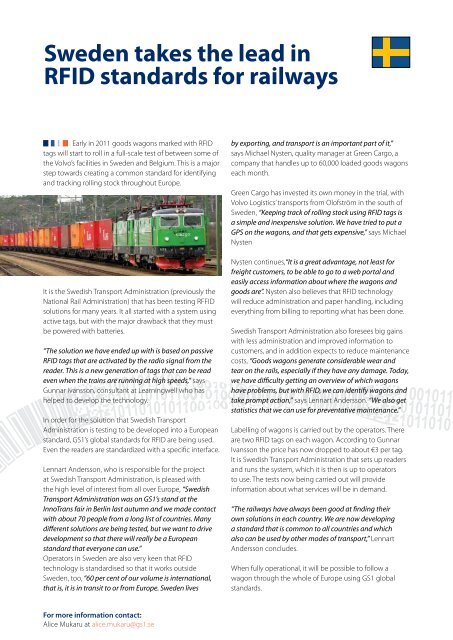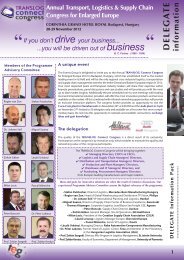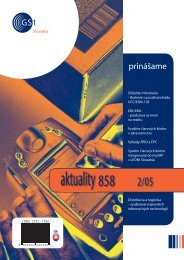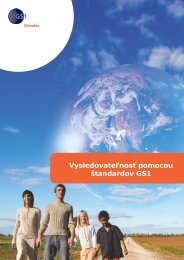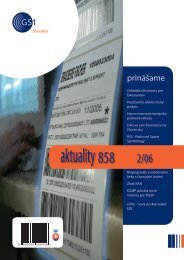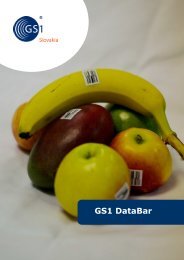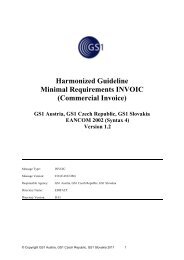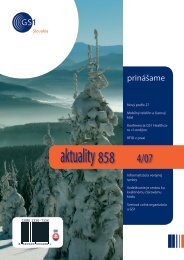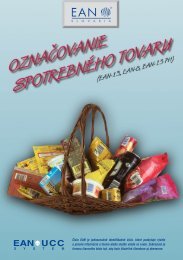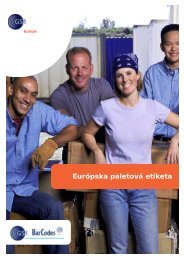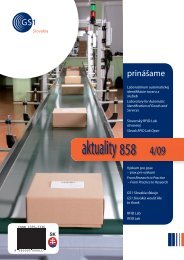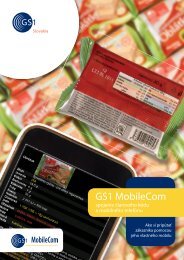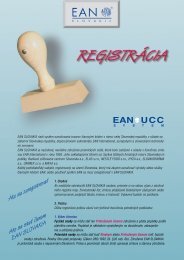GS1 StandardS in tranSport, LoGiSticS and cuStomS - GS1 Slovakia
GS1 StandardS in tranSport, LoGiSticS and cuStomS - GS1 Slovakia
GS1 StandardS in tranSport, LoGiSticS and cuStomS - GS1 Slovakia
Create successful ePaper yourself
Turn your PDF publications into a flip-book with our unique Google optimized e-Paper software.
Sweden takes the lead <strong>in</strong><br />
RFID st<strong>and</strong>ards for railways<br />
Early <strong>in</strong> 2011 goods wagons marked with RFID<br />
tags will start to roll <strong>in</strong> a full-scale test of between some of<br />
the Volvo’s facilities <strong>in</strong> Sweden <strong>and</strong> Belgium. This is a major<br />
step towards creat<strong>in</strong>g a common st<strong>and</strong>ard for identify<strong>in</strong>g<br />
<strong>and</strong> track<strong>in</strong>g roll<strong>in</strong>g stock throughout Europe.<br />
It is the Swedish Transport Adm<strong>in</strong>istration (previously the<br />
National Rail Adm<strong>in</strong>istration) that has been test<strong>in</strong>g RFFID<br />
solutions for many years. It all started with a system us<strong>in</strong>g<br />
active tags, but with the major drawback that they must<br />
be powered with batteries.<br />
“The solution we have ended up with is based on passive<br />
RFID tags that are activated by the radio signal from the<br />
reader. This is a new generation of tags that can be read<br />
even when the tra<strong>in</strong>s are runn<strong>in</strong>g at high speeds,” says<br />
Gunnar Ivansson, consultant at Learn<strong>in</strong>gwell who has<br />
helped to develop the technology.<br />
In order for the solution that Swedish Transport<br />
Adm<strong>in</strong>istration is test<strong>in</strong>g to be developed <strong>in</strong>to a European<br />
st<strong>and</strong>ard, <strong>GS1</strong>’s global st<strong>and</strong>ards for RFID are be<strong>in</strong>g used.<br />
Even the readers are st<strong>and</strong>ardized with a specific <strong>in</strong>terface.<br />
Lennart Andersson, who is responsible for the project<br />
at Swedish Transport Adm<strong>in</strong>istration, is pleased with<br />
the high level of <strong>in</strong>terest from all over Europe, “Swedish<br />
Transport Adm<strong>in</strong>istration was on <strong>GS1</strong>’s st<strong>and</strong> at the<br />
InnoTrans fair <strong>in</strong> Berl<strong>in</strong> last autumn <strong>and</strong> we made contact<br />
with about 70 people from a long list of countries. Many<br />
different solutions are be<strong>in</strong>g tested, but we want to drive<br />
development so that there will really be a European<br />
st<strong>and</strong>ard that everyone can use.”<br />
Operators <strong>in</strong> Sweden are also very keen that RFID<br />
technology is st<strong>and</strong>ardised so that it works outside<br />
Sweden, too, “60 per cent of our volume is <strong>in</strong>ternational,<br />
that is, it is <strong>in</strong> transit to or from Europe. Sweden lives<br />
by export<strong>in</strong>g, <strong>and</strong> transport is an important part of it,”<br />
says Michael Nysten, quality manager at Green Cargo, a<br />
company that h<strong>and</strong>les up to 60,000 loaded goods wagons<br />
each month.<br />
Green Cargo has <strong>in</strong>vested its own money <strong>in</strong> the trial, with<br />
Volvo Logistics’ transports from Olofström <strong>in</strong> the south of<br />
Sweden, “Keep<strong>in</strong>g track of roll<strong>in</strong>g stock us<strong>in</strong>g RFID tags is<br />
a simple <strong>and</strong> <strong>in</strong>expensive solution. We have tried to put a<br />
GPS on the wagons, <strong>and</strong> that gets expensive,” says Michael<br />
Nysten<br />
Nysten cont<strong>in</strong>ues,“It is a great advantage, not least for<br />
freight customers, to be able to go to a web portal <strong>and</strong><br />
easily access <strong>in</strong>formation about where the wagons <strong>and</strong><br />
goods are”. Nysten also believes that RFID technology<br />
will reduce adm<strong>in</strong>istration <strong>and</strong> paper h<strong>and</strong>l<strong>in</strong>g, <strong>in</strong>clud<strong>in</strong>g<br />
everyth<strong>in</strong>g from bill<strong>in</strong>g to report<strong>in</strong>g what has been done.<br />
Swedish Transport Adm<strong>in</strong>istration also foresees big ga<strong>in</strong>s<br />
with less adm<strong>in</strong>istration <strong>and</strong> improved <strong>in</strong>formation to<br />
customers, <strong>and</strong> <strong>in</strong> addition expects to reduce ma<strong>in</strong>tenance<br />
costs, “Goods wagons generate considerable wear <strong>and</strong><br />
tear on the rails, especially if they have any damage. Today,<br />
we have difficulty gett<strong>in</strong>g an overview of which wagons<br />
have problems, but with RFID, we can identify wagons <strong>and</strong><br />
take prompt action,” says Lennart Andersson. “We also get<br />
statistics that we can use for preventative ma<strong>in</strong>tenance.”<br />
Labell<strong>in</strong>g of wagons is carried out by the operators. There<br />
are two RFID tags on each wagon. Accord<strong>in</strong>g to Gunnar<br />
Ivansson the price has now dropped to about €3 per tag.<br />
It is Swedish Transport Adm<strong>in</strong>istration that sets up readers<br />
<strong>and</strong> runs the system, which it is then is up to operators<br />
to use. The tests now be<strong>in</strong>g carried out will provide<br />
<strong>in</strong>formation about what services will be <strong>in</strong> dem<strong>and</strong>.<br />
“The railways have always been good at f<strong>in</strong>d<strong>in</strong>g their<br />
own solutions <strong>in</strong> each country. We are now develop<strong>in</strong>g<br />
a st<strong>and</strong>ard that is common to all countries <strong>and</strong> which<br />
also can be used by other modes of transport,” Lennart<br />
Andersson concludes.<br />
When fully operational, it will be possible to follow a<br />
wagon through the whole of Europe us<strong>in</strong>g <strong>GS1</strong> global<br />
st<strong>and</strong>ards.<br />
For more <strong>in</strong>formation contact:<br />
Alice Mukaru at alice.mukaru@gs1.se


